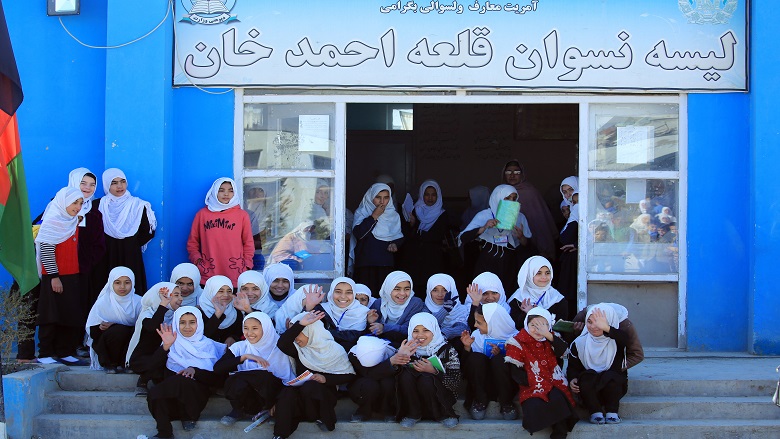World Bank's Infrastructure Development Grant helping better girl education in Kabul
The building was constructed with support from the Educational Quality Improvement Program (EQUIP). In 2013, EQUIP provided an Infrastructure Development Grant (IDG) of $98,000 to the village Community Development Council.

- Country:
- Afghanistan
Thirteen-year-old Rukhsar and her 30 classmates, seated comfortably on wooden chairs in a warm, white classroom, are busy writing their final exam to become seventh graders. Outside the recently constructed building at Qala-e-Ahmad Khan Girls High School, other students are in the schoolyard holding hands and running in circles during their break.
Later, Rukhsar recalls going to school before there was a new school building: “When our school was in a tent, the temperature was always uncomfortable,” she says. “It was either too warm or too cold and it was hard for me to learn anything, but now it is good.”
Qala-e-Ahmad Khan Girls High School is in Qala-e-Ahmad Khan village in Bagrami district of Kabul province. Although called a high school, it enrolls students from Grades 1 to 12. In 2012, it had only two buildings for its 2,200 students, who were mostly girls, but also included boys in Grades 1 to 4. Many students, like Rukhsar, had to study in a tent. Each season brought a new challenge to the students—the rainy days of spring, followed by hot summers and cold autumn weather made studying a daily discomfort for hundreds of students and teachers.
A Better Place to Learn
Teacher Zakira, 34, who has taught third grade at the school for 10 years, recollects their difficulties in having to teach outdoors. “I remember once a strong wind overturned the tent while I was teaching inside. Luckily, no one was injured, but the fear and stress of that accident remained throughout the year with the students and even myself,” she says.
Today, she is teaching her students before the winter break in a proper classroom in the blue modern concrete build"Having proper classrooms has affected both students and teachers,” Zakira says, “it encourages students to come to class on time and it enables us to teach the subjects without distraction.”
The building was constructed with support from the Educational Quality Improvement Program (EQUIP). In 2013, EQUIP provided an Infrastructure Development Grant (IDG) of $98,000 to the village Community Development Council, which used it to build a modern 10-room building from 2013 to 2015. The new building addressed the space shortage and helped increase enrollment.
EQUIP, which closed in December 2017, sought to increase equitable access to quality basic education, especially for girls. It was implemented by the Ministry of Education and funded by the Afghanistan Reconstruction Trust Fund (ARTF) and the International Development Association (IDA), the World Bank Group’s fund for the poorest countries.
Government, donors and the World Bank are currently working to prepare the next phase of education funding, which will continue to focus on increasing equitable access to education, especially for girls.
The World Bank is working with the Ministry of Education to prepare a follow-on project, EQRA, which aims to increase equitable access to primary and secondary education in selected provinces that are lagging behind, especially for girls, and to improve learning conditions in schools and transparency in the Ministry of Education’s resource management.
Better Quality of Learning
In addition to the IDG, Qala-e-Ahmad Khan Girls High School also received a Quality Enhancement Grant of 390,000 afghanis (about $5,500) from EQUIP. The School Management Shura (council) used the money to set up a computer lab and library, including buying books and furniture.
The School Management Shura also bought 21 desktop computers, a projector, and other materials for the computer lab. As a result, students have been able to put their theoretical computer lessons into practice and experience the new technology.
Mohammad Ibrahim Muhammadi, the school’s principal, says EQUIP support has helped increase the quality of education. “Just five years ago, we used to teach our students in a tent or in the open air. EQUIP’s support has helped us to have a proper building as well as enough materials and facilities, like a computer lab and a library,” he says. “It has increased the quality of education.”
Ibrahim also believes that the project support and establishment of the shura has brought the community and school closer. The shura, which meets monthly, plans to construct a small building for the school management in the coming year.
“Over the past few years, our classes have come out from the tents, and now thrive in modern concrete classrooms. We have enough materials, but as the population grows every year, we would like to have further support from the Ministry of Education in the future too to help us meet our needs,” adds Ibrahim. The school’s population has grown. Today, 60 teachers offer instruction to more than 3,900 students (a 77 percent increase since 2012) in three daily sessions.
Qala-e-Ahmad Khan Girls High School is busy, but ninth grader Sonia, 16, is pleased with the facilities. “In the past, we did not even have a classroom. Now we have good classes and teachers,” she says. “When we do not know something or want to learn more about a subject, we use the library. Everything is going well and we are so thankful for the government that supported us.”
ALSO READ
Students should be in school instead of protesting
Peon held for sexual assault on 7-year-old girl on school premises in Mumbai
British PM Rishi Sunak unveils GBP 35 million investment in grassroots cricket to widen participation in schools
India's top court puts order banning Islamic schools on hold
HC extends protection to school management over case relating to PM's Coimbatore roadshow










